

PI TeensandTech Update2015 0409151. Tom Wujec: Build a tower, build a team. Ohr_89185.pdf. Ice Breaker Videos - Tag Games. The Marshmallow Challenge. School Makerspaces: Building the Buzz. If you build it, will they come?
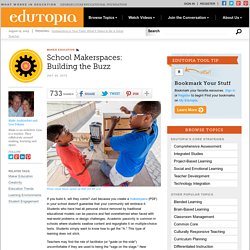
Just because you create a makerspace (PDF) in your school doesn't guarantee that your community will embrace it. Students who have had all personal choice removed by traditional educational models can be passive and feel overwhelmed when faced with real-world problems or design challenges. Academic passivity is common in schools where students swallow content and regurgitate it on multiple-choice tests. Students simply want to know how to get the "A. " Academic Sponge Activities.
To put your rough days into perspective, here is a teaching story that is equal parts nightmare and exemplar, adapted from Alan Newland's personal account in The Guardian.
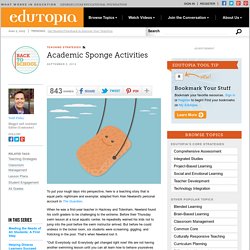
When he was a first-year teacher in Hackney and Totenham, Newland found his sixth graders to be challenging to the extreme. Before their Thursday swim lesson at a local aquatic center, he repeatedly warned his kids not to jump into the pool before the swim instructor arrived. Group Work Strategies to Ensure Students Pull Their Weight. The idea for sharing this post came from a session I recently conducted at the annual teaching conference organized by my university.
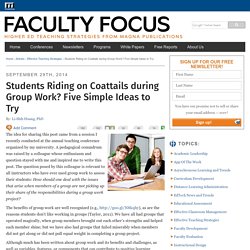
A pedagogical conundrum was raised by a colleague whose enthusiasm and question stayed with me and inspired me to write this post. The question posed by this colleague is relevant to all instructors who have ever used group work to assess their students: How should one deal with the issues that arise when members of a group are not picking up their share of the responsibilities during a group work project? Finley-sponge-activities.pdf. Group Work Strategies to Ensure Students Pull Their Weight. What We Have and Haven’t Learned. I’ve been asked to give a talk that explores some of the top teaching-learning lessons learned in the past 15 years.
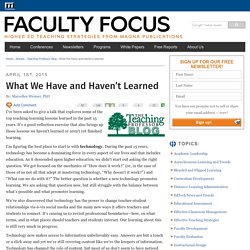
It’s a good reflection exercise that also brings up those lessons we haven’t learned or aren’t yet finished learning. I’m figuring the best place to start is with technology. During the past 15 years, technology has become a dominating force in every aspect of our lives and that includes education. As it descended upon higher education, we didn’t start out asking the right question. We got focused on the mechanics of “How does it work?” We’ve also discovered that technology has the power to change teacher-student relationships vis-à-vis social media and the many new ways it offers teachers and students to connect. Technology now makes access to information unbelievably easy.
Animate Your Course Book with Engaging Activities. I never teach my pupils.

10 ways to use Google Plus in the classroom. Using Positive Interdependence. Dl-sponge-activities. A Look Inside the Classroom of the Future. Over the next generation, whether they work for corporations, small businesses, government organizations, nonprofits, or other organizations, many U.S. employees will move from working primarily with American colleagues, bosses, and customers for American organizations in U.S. cities, to being part of global teams.

As leaders, they will use technology to bridge geographic divides, build organizations that transcend borders, and work together with colleagues from around the world on issues such as climate change, food security, and population growth -- issues that require multinational teams coming together to effect change. For those whose work is closer to home, the changing demographics of the U.S. will mean that their colleagues, customers, and neighbors may look a lot less like them, and have fewer shared histories than American colleagues, customers, and neighbors have shared in the past. 1.
10 Signs of a 21st Century Classroom. Posted 02/27/2015 10:58AM | Last Commented 04/16/2015 2:42PM One of my early challenges in coordinating my school’s STEM efforts has been determining exactly what is meant by a STEM school.

There are probably as many answers to this question as there are educators, but I have decided to focus on what goes on inside the classroom. Not just in a science or math class, but in all classrooms. There are some activities that have traditionally been done well by the STEM disciplines that can be cross applied to all subjects. 15.jayapraba.pdf. PBL Pilot: Navigating Group Work. Editor's Note: Matt Weyers and co-author Jen Dole, teachers at Byron Middle School in Byron, Minnesota, present the sixth installment in a year-long series documenting their experience of launching a PBL pilot program.
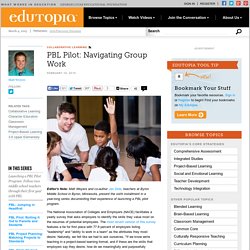
The National Association of Colleges and Employers (NACE) facilitates a yearly survey that asks employers to identify the skills they value most on the resumes of potential employees. The most recent version of this survey features a tie for first place with 77.8 percent of employers listing "leadership" and "ability to work in a team" as the attributes they most desire. Quiz Tank 10: Partner Work: Promising or full of Pitfalls? View Original Photo As educators, much of our time is spent assessing student needs.
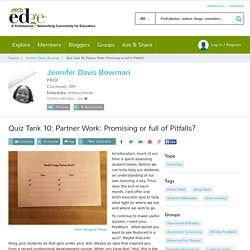
Before we can truly help our students, an understanding of our own learning is key.